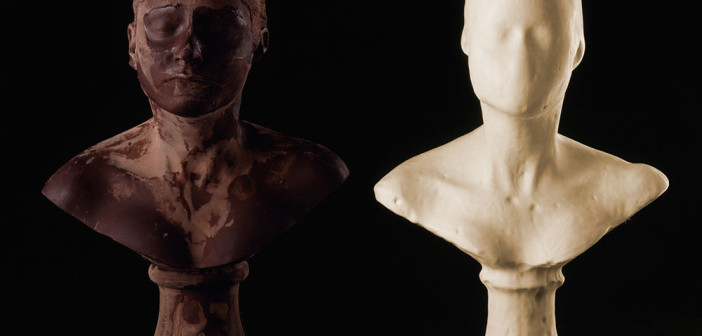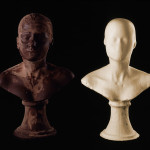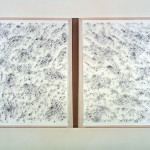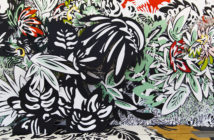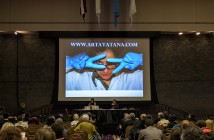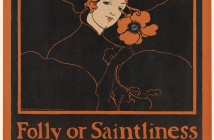I first heard of Janine Antoni in the early '90s when I saw a few photos in a magazine: a still from Loving Care, an installation shot of Gnaw, and a photo of Butterfly Kisses. At that point in my life, I knew almost nothing about art, let alone contemporary artists, but as someone consumed with process both professionally and creatively, I was instantly fascinated by Antoni's work. Within the week, I'd tried making my own mascara drawing to confirm my suspicions: that if I didn't get lash to paper right away, the mascara would be too dry to leave much of a mark, and that the friction of the whole enterprise would be exhausting (confirmed and confirmed). Without the slightest idea what Butterfly Kisses was trying to say, I took from it a message about endurance, and recognized in it a kind of tribute to the sublime rewards of process. Plus, realizing I'd been ritually coating my eyelashes with makeup every day and then not doing anything very industrious or satisfying with them was a brand new take to me on the idea of questioning ideals of feminine beauty. My eyelashes, I suddenly recognized, were certainly a tool, but whose benefit had I been putting them to work for?
 Janine Antoni
Janine AntoniButterfly Kisses, 1993
Cover Girl Thick Lash Mascara, 1124 winks per eye
Diptych, each 22 1/8 X 15 inches
Antoni probably would have been happy to know all this. Speaking on November 14 at Boston University's College of Fine Arts as part of the Contemporary Perspectives lecture series, Antoni mentioned more than once that she's always been interested in what the viewer imagines she's gone through in making her work. Presenting a selection of slides and videos, she talked about some of the main ideas and themes she's explored throughout her career: the body as a tool, issues of women and beauty in our culture (and art history), connection and absence, the self and the other. She's perhaps best known for works likeGnaw, and Lick & Lather—works based on "objects," she says, "that mediate our interaction with the body"—created and performed upon (chewed, washed, licked, or otherwise abraded or rubbed against with the body) in private and exhibited in their after-states as records or artifacts of her process; and for pieces like Slumber and To Draw a Line, that mix performance with sculptural objects or constructions loaded with personal and cultural reference points. But she's worked in a wide range of materials and formats, including recent collaborations with choreographers Stephen Petronio and Anna Halprin, always bringing the same intensely personal, contemplative approach to the universals she's addressing.
"My work is like coming in on the scene of a crime," Antoni says, "and the viewer slowly figuring out what happened." Maybe I read too many serial killer novels, but when I hear "scene of the crime," I think horrific, and Antoni's work is anything but at first glance. Even a piece like Saddle—the translucent, shaved hide of a cow hardened into the shape of Antoni's body on hands and knees—feels more reverential than violent, and any sadness I see in her work lies well below the surface, waiting to be sussed out (Wean, for example, is about "the separation we go through from our own bodies as we're weaned into the culture.")
For Antoni, a process-oriented artist, the act of making the work is as important as the end result. Now, she says, she's looking for ways to shift from having that experience herself, to giving the experience to the viewer. She didn't elaborate beyond that, but I'm game, as long as it doesn't involve mascara.
- Janine Antoni Lick and Lather, 1993 Two self-portrait busts: one chocolate and one soap 24 X 16 X 13 inches (60.96 X 40.64 X 33.02 cm) Photographed by John Bessler
- Janine Antoni Butterfly Kisses, 1993 Cover Girl Thick Lash Mascara, 1124 winks per eye Diptych, each 22 1/8 X 15 inches
- Janine Antoni Gnaw, 1992 Installation shot (LA Moca) 600 lbs. of chocolate gnawed by the artist (24 x 24 x 24 inches); 600 lbs. of lard, gnawed by the artist (24 X 24 X 24 inches); 45 heart-shaped packages for chocolate made from chewed chocolate removed from the chocolate cube and 150 lipsticks made with pigment, beeswax and chewed lard removed from the lard cube
- Janine Antoni To Draw a Line, 2003 Performance Documentation 4000 lbs. of Raw Hemp Fiber 120 feet of hand made Hemp Rope spliced into 1200 feet of Machine made Hemp Rope 2 Recycled Steel Reels 140 Lead Ingots with a total weight of 13,300lbs. 2 Steel Ramps with a 20% incline 4 Steel and Rubber Laminated chocks 35 x 20 x 10 feet

